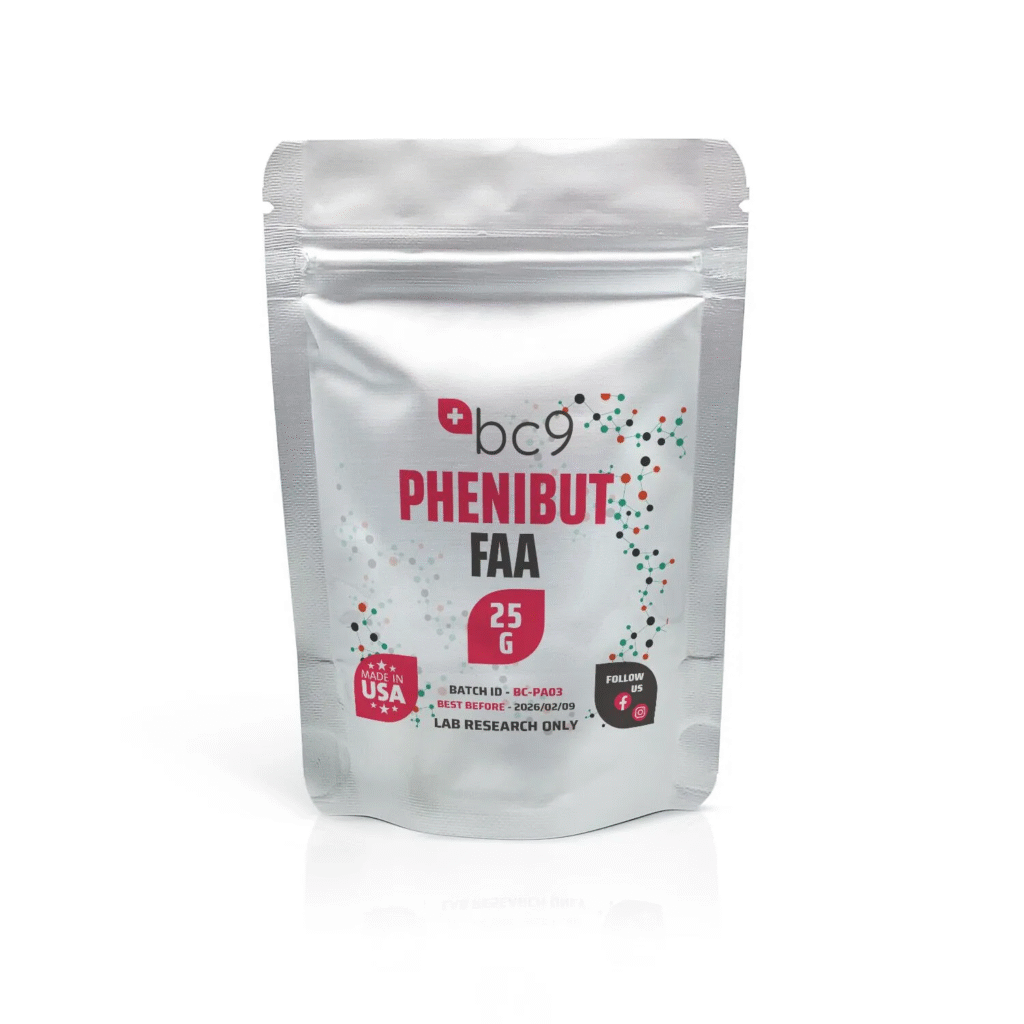Phenibut FAA (Free Amino Acid form of β-phenyl-γ-aminobutyric acid) is a research compound often discussed in nootropic communities for its potential influence on GABA-B receptors, stress response, and relaxation. Although widely mentioned online, it is not an FDA-approved drug, has limited clinical research, and has documented risks involving dependency, withdrawal, and tolerance. Any use should follow strict harm-reduction principles, and information here is for educational purposes only.
What Makes Phenibut FAA Different From HCL
Phenibut is typically available in two forms: FAA (free amino acid) and HCL (hydrochloride). These variations differ in purity, acidity, taste, and how users report absorption.
| Feature | Phenibut FAA | Phenibut HCL |
| Form | Powdered free amino acid | Hydrochloride salt |
| Reported Taste | Mild, chalky | Highly acidic, sour |
| Density | Slightly lighter per volume | Heavier per volume |
| Use Cases in Research | Sublingual and oral | Oral only |
| Water Solubility | Low | High |
How Phenibut FAA Works in the Body (Research-Based Overview)
Phenibut FAA is structurally similar to GABA, the brain’s main inhibitory neurotransmitter. Published research indicates it crosses the blood-brain barrier more effectively than GABA itself, potentially affecting:
- GABA-B receptor activity
- Stress response pathways
- Muscle tension and sleep regulation
- Dopamine signaling
Some animal-based studies have reported sedative, anxiolytic, and neuroprotective properties, but human clinical data remains limited. Because it affects GABAergic pathways, the compound carries risks similar to other GABA-acting substances including tolerance, dependence, and severe withdrawal if misused.
Harm-Reduction Guidelines for Responsible Use
Because Phenibut has a documented history of overuse and dependency issues, harm-reduction is critical:
- Avoid daily use
- Avoid combining with other depressants (alcohol, benzodiazepines, opioids, sleep medications)
- Avoid high or escalating intake
- Never mix with driving, operating machinery, or decision-heavy tasks
- Do not use if there is a history of substance addiction
Many individual reports describe difficulty stopping after prolonged or high-intensity usage. Sudden cessation after heavy use has been associated with withdrawal symptoms like insomnia, tremors, heightened anxiety, and cardiovascular stress.
General Research-Based Dosage Ranges (Educational Context Only)
Scientific literature describing human research with Phenibut is limited. Some published Russian clinical sources report measured doses under medical supervision for specific therapeutic contexts. It’s important to note:
- This compound is not approved for medical treatment in many regions
- Self-experimentation carries risk
- Tolerance can develop quickly
- Higher doses increase the chance of severe side effects
Because of safety concerns, many harm-reduction communities emphasize low, infrequent usage patterns rather than daily intake.
How Long Phenibut FAA Takes to Work
Reported onset and duration vary widely:
- Onset: 2–4 hours (sometimes longer)
- Peak effects: 4–6 hours
- Lingering effects: 12–24 hours or more depending on sensitivity and intake amount
Because onset can be delayed, repeatedly taking more before it’s fully absorbed increases overdose risk.
Signs of Excessive or Risky Use
Researchers and clinicians have documented a pattern of escalating intake and physical dependence in misuse cases. Risk indicators include:
- Needing larger amounts to feel the same effect
- Using more than planned
- Anxiety or insomnia between uses
- Withdrawal discomfort when stopping
- Using multiple days per week
- Combining with alcohol or sedatives
Anyone experiencing these symptoms should seek medical support, as abrupt discontinuation may be dangerous.
Possible Side Effects
Reported side effects include:
- Drowsiness
- Dizziness or coordination problems
- Gastrointestinal discomfort
- Mood swings or irritability
- Rebound anxiety
- Rapid heart rate
- Severe withdrawal after heavy use
Medical case studies have described hospitalization in individuals who combined Phenibut with alcohol or other depressants, or who escalated usage rapidly.
Phenibut FAA vs Other Stress-Relief Compounds
In comparison to natural supplements like L-Theanine, Kava, or magnesium glycinate, Phenibut interacts more strongly with GABA pathways and carries higher dependency risk. Most natural supplements lack the same withdrawal concerns.
Legal and Access Status
Phenibut’s status varies:
- Not FDA-approved in the United States
- Restricted or controlled in multiple countries
- Often labeled and sold only as a research compound
- Not intended for human consumption or therapeutic use
Because of safety concerns and regulatory differences, people often search for general informational terms such as “Phenibut FAA for sale” to understand legality and sourcing. In many regions, purchasing or selling Phenibut for human ingestion violates regulatory guidelines.
Always check local laws before acquiring any research compound.
When to Seek Medical Help
Immediate professional care is recommended if symptoms such as:
- Confusion or loss of coordination
- Irregular heartbeat
- Severe anxiety or panic
- Hallucinations
- Uncontrollable shaking
- Thoughts of self-harm
Clinicians can assist with withdrawal management and safer tapering protocols if needed.
Final Scientific Perspective
Phenibut FAA is a powerful GABA-acting research compound with a history of dependency concerns, regulatory restrictions, and medical case reports documenting misuse. Anyone exploring scientific literature or experimentation should prioritize safety, legality, and medical guidance. Responsible, infrequent use and awareness of interactions drastically reduce risk.
If needed, a more detailed section can cover comparisons with natural anxiolytics, alternative coping tools, or best practices for stress management that do not involve high-risk compounds.

